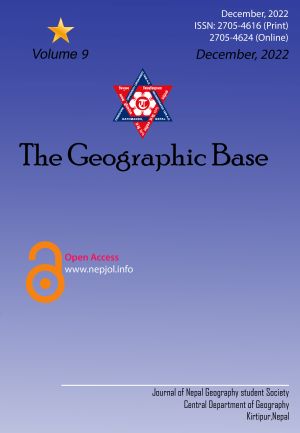Assessment of Land Use Land Cover and River Dynamics of Himalaya: Seti River Sub-Basin of Nepal
DOI:
https://doi.org/10.3126/tgb.v9i1.55440Keywords:
Land use land cover, Sinuosity, Water management, Change detection, Remote sensingAbstract
In rapidly growing areas, land use land cover (LULC) change is one of the most pre-eminent features of environmental changes produced by human-induced activities. LULC changes are critical issues and challenges for environmentally friendly and sustainable development. Understanding land-use and land-cover (LULC) changing patterns is critical for sustainable environmental management, particularly effective water management. This study was focused on the assessment of LULC and sinuosity of the Seti River sub-Basin over 28 years. Satellite imagery of Landsat series (MS, TM, and OLI) were classified using maximum likelihood classifier to create LULC maps for 1991, 2004 and 2019. The LULC change was assessed using change detection analysis and verified the result by confuse matrix. The results showed that forest cover is regaining its original status with the increasing rate of 1.31%. In the meantime, built-up areas are expanding with the rate of 2.62% while agricultural land has decreased with the rate of -1.89% per year and are more converted to built-up area. Trendofsinuosityindexfoundincreasing and varying in different sections of the river path indicated the complex response of changing characteristics of river flow, river mining and geomorphology of landscape. Based on research findings and descriptions from earlier works, river morphology is affected by both natural (topography, climate, precipitation), and anthropogenic (rapid urbanization, foreign labor migration, abandonment of cultivable land, community forest programs, development activities) factors.
Downloads
Downloads
Published
How to Cite
Issue
Section
License
© Nepal Geography Student Society




